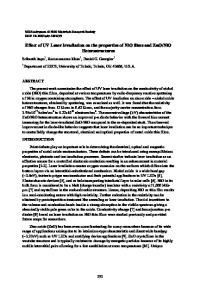The effects of UV laser irradiation on the filament-assisted deposition of diamond
- PDF / 2,432,884 Bytes
- 8 Pages / 593.28 x 841.68 pts Page_size
- 85 Downloads / 277 Views
I. INTRODUCTION
Diamond has many physical properties which make it attractive as an electronic material.1 For many applications, the ability to prepare particular structures of a material is important. Monocrystalline diamond has been directly patterned using 193 nm radiation at high fluence (20 J • cm"2).2 Another approach is to pattern diamond films during deposition. At present, the most reliable way to control the nucleation of diamond is to scratch the surface with diamond grit, followed by etching of the surface3"5 or site-blocking.5 Alternate methods of deposition are clearly needed, particularly as a way of reducing the substrate temperatures at which diamond deposition occurs. Control of nucleation and application to patterning thus is seen as critical for realizing some electronic applications. Kitihama et al.6 reported the deposition of diamond using 193 nm irradiation of a 2% C 2 H 2 in H 2 mixture at flow rates of 10-100 seem and total pressures of 8-75 Torr. The best deposits, thought to be diamond-containing crystals from the RHEED pattern, were obtained with the diamond-scratched Si substrate heated to 400 CC, and with near-parallel laser irradiation (100 Hz repetition rate for 2 h) with a fluence of 10-50 mJ • cm"2. Under focused laser conditions (300 mJ pulse energy; unknown energy density), ablation occurred, but particles giving the same RHEED pattern were observed in the periphery of the laser
a)NRC/NRL
Postdoctoral Fellow. Current address: M.S. 147, Materials Science Laboratory, Texas Instruments, P. O. Box 655936, Dallas, Texas 75265. b)Code 6111.
J. Mater. Res., Vol. 5, No. 11, Nov 1990
http://journals.cambridge.org
Downloaded: 23 Mar 2015
spot. Unfortunately, the deposits from the above study were re-examined and found to be random layers of graphitic carbon.7 The laser-assisted deposition of diamond on Si, as verified by Raman spectroscopy and RHEED, was recently reported by Goto et al.s Excimer laser radiation at 193 nm was used with 0.1-1% carbon tetrachloride (CC14)/H2 mixtures (1000 seem flow, P = 6-50 Torr) in the anticipation that enhanced dissociation of the CC14 by absorption of the UV light would increase the yield of diamond-forming precursors. A 30 cm lens was used to focus the laser beam (total pulse energy of 80200 mJ), but the energy density was not reported. An independent method for creating atomic hydrogen (hot filament or microwave source) was found to be necessary for diamond formation. Without the atomic hydrogen source, an amorphous carbon film containing some Cl and O impurities was produced. The substrate temperature was reported to be 450 °C. Details regarding deposits outside of the laser irradiation area were not given. Emission spectra from fragments of CC14 (CC1, C, Cl) as well as C2 were observed, although it is unclear from the report whether the spectra were collected during the diamond deposition. The results match other claims910 that observation of excited-state CH* emission correlates with diamond growth while more intense C* emission favors graphi
Data Loading...








